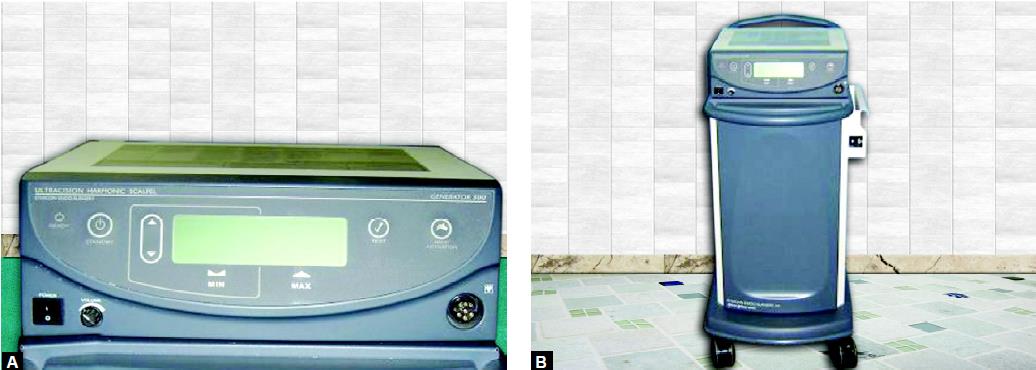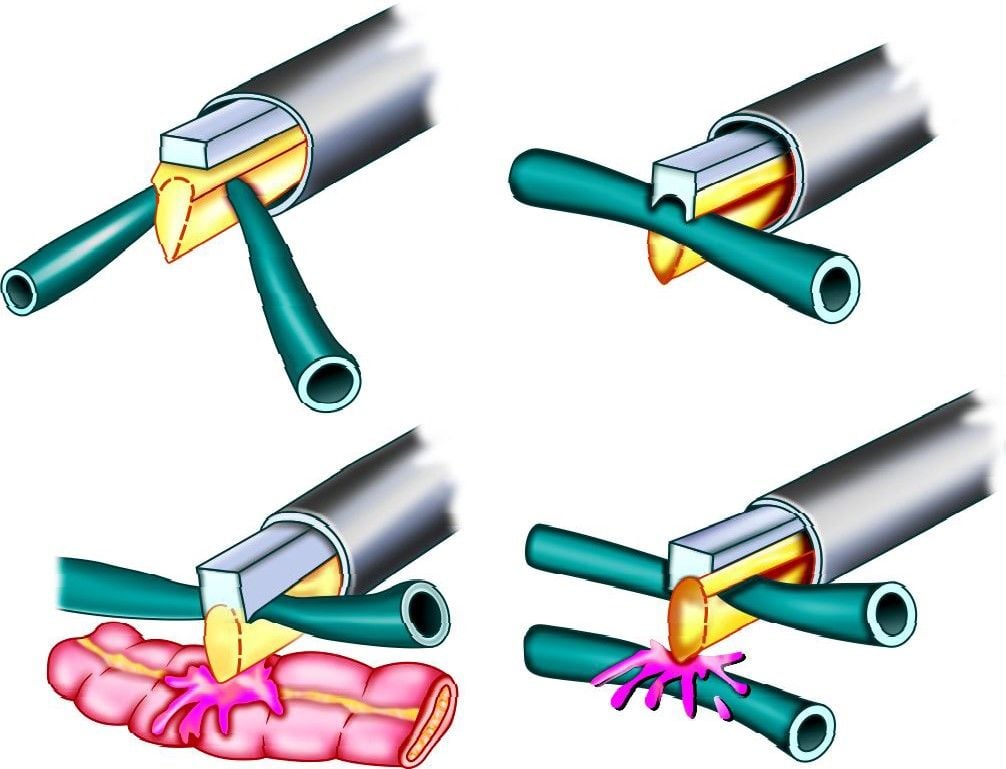Use of Ultrasonic Dissection in Laparoscopic Surgery
Ultrasonic dissectors are of two types: low power which cleaves water-containing tissues by cavitations leaving organized structures with low water content intact, e.g. blood vessels, bile ducts, etc. and high power systems which cleave loose areolar tissues by frictional heating and thus cut and coagulate the edges at the same time. Thus, low power systems are used for liver surgery (Cusa, Selector) and do not coagulate vessels. High power systems (Autosonix, Ultracision) are used extensively especially in fundoplication and laparoscopic colon surgery. It is important to remember that high power ultrasonic dissection systems may cause collateral damage by excessive heating and this is well documented in clinical practice.
Ultrasonic surgical dissection allows coagulation and cutting with less instrument traffic (reduction in operating time), less smoke, and no electrical current.
• Mechanical energy at 55,500 vibrations/sec
• Disrupts hydrogen bonds and forms a coagulum
• Temperature by harmonic scalpel, 80-100°C
• Temperature through electrocoagulation, 200-300°C
• Less collateral damage, less tissue necrosis.
The ultrasonic shears (harmonic scalpel) is ideal for dividing and simultaneously sealing small and medium vessels by tamponade and heat. However, larger vessels, greater than 2 mm in diameter, need additional measures (clips, tie or staple) to control bleeding. Other disadvantages of the harmonic scalpel include lack of tissue selectivity and relatively expensive. Ultrasonic dissecting applicators are also designed in hook, spatula, or ball coagulator shapes.

Ultrasonic generator
The cavitational ultrasonic aspirator has the advantage of removing debris and is tissue-selective, e.g. divides liver but spares bile ducts and vessels. It affords safe rapid dissection with a reduction in tissue damage and blood loss compared to the harmonic scalpel. The problems associated with its use are the evacuation of the pneumoperitoneum together with vibration and irrigation which cloud the telescope lens necessitating frequent cleaning. It is not correct that ultrasonic generators are without any risk. If bowel or blood vessels touch directly to the vibrating jaw it can be punctured.

Harmonic Scalpel
High-Velocity Water Jet Dissection
High-velocity high-pressure water-jet dissection involves the use of relatively simple devices to produce clean cutting of reproducible depth. Other advantages are the cleansing of the operating field by the turbulent flow zone and the small amount of water required to complete dissection.
Specific problems were identified with the use of this modality. The “hail storm” effect results in excessive misting which obscures vision. This has been solved to some extent by incorporating a hood over the nozzle. The non-hemostatic nature of this modality, difficulty in gauging distance, and poor control of the depth of the cut are additional drawbacks. The spraying of tissue fragments renders it also oncologically unsound. The present use of water-jet dissection is limited to the dissection of solid organs.
Ultrasonic dissectors are of two types: low power which cleaves water-containing tissues by cavitations leaving organized structures with low water content intact, e.g. blood vessels, bile ducts, etc. and high power systems which cleave loose areolar tissues by frictional heating and thus cut and coagulate the edges at the same time. Thus, low power systems are used for liver surgery (Cusa, Selector) and do not coagulate vessels. High power systems (Autosonix, Ultracision) are used extensively especially in fundoplication and laparoscopic colon surgery. It is important to remember that high power ultrasonic dissection systems may cause collateral damage by excessive heating and this is well documented in clinical practice.
Ultrasonic surgical dissection allows coagulation and cutting with less instrument traffic (reduction in operating time), less smoke, and no electrical current.
• Mechanical energy at 55,500 vibrations/sec
• Disrupts hydrogen bonds and forms a coagulum
• Temperature by harmonic scalpel, 80-100°C
• Temperature through electrocoagulation, 200-300°C
• Less collateral damage, less tissue necrosis.
The ultrasonic shears (harmonic scalpel) is ideal for dividing and simultaneously sealing small and medium vessels by tamponade and heat. However, larger vessels, greater than 2 mm in diameter, need additional measures (clips, tie or staple) to control bleeding. Other disadvantages of the harmonic scalpel include lack of tissue selectivity and relatively expensive. Ultrasonic dissecting applicators are also designed in hook, spatula, or ball coagulator shapes.

Ultrasonic generator
The cavitational ultrasonic aspirator has the advantage of removing debris and is tissue-selective, e.g. divides liver but spares bile ducts and vessels. It affords safe rapid dissection with a reduction in tissue damage and blood loss compared to the harmonic scalpel. The problems associated with its use are the evacuation of the pneumoperitoneum together with vibration and irrigation which cloud the telescope lens necessitating frequent cleaning. It is not correct that ultrasonic generators are without any risk. If bowel or blood vessels touch directly to the vibrating jaw it can be punctured.

Harmonic Scalpel
High-Velocity Water Jet Dissection
High-velocity high-pressure water-jet dissection involves the use of relatively simple devices to produce clean cutting of reproducible depth. Other advantages are the cleansing of the operating field by the turbulent flow zone and the small amount of water required to complete dissection.
Specific problems were identified with the use of this modality. The “hail storm” effect results in excessive misting which obscures vision. This has been solved to some extent by incorporating a hood over the nozzle. The non-hemostatic nature of this modality, difficulty in gauging distance, and poor control of the depth of the cut are additional drawbacks. The spraying of tissue fragments renders it also oncologically unsound. The present use of water-jet dissection is limited to the dissection of solid organs.





